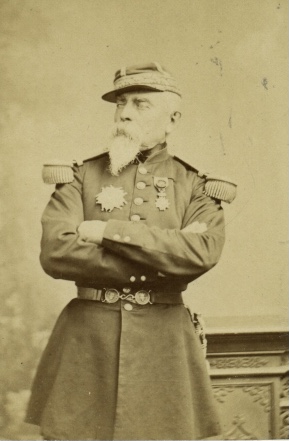These two gun sets represent the two light field batteries that served with the Third Division, Captain Stofel's 7/15th Battery and Captain Bèguin's 8/15th Battery.
At Spicheren on 6 August, 1870 these two batteries, along with Laurent's mitrailleuse battery, were in the thick of the action from the very start. Two sections of Bèguin's battery had been positioned behind a low earthwork on the Rotherberg and fired the opening shots of the battle when German cavalry appeared on the hills south of Saarbrücken. The other section was held further back with Stofel's battery. At around 1:00 PM the Germans were ready to attack and four batteries opened on Bèguin's guns. Immediately a third section was brought forward, but oddly it was not Bèguin's, but one of Stofel's sections that came forward.
Although he was facing the fire of 24 guns with just six, Bèguin suffered very little damage initially because the Germans suffered from a technical disadvantage - a rare situation for them in this war. The German batteries were engaging from an elevation 100 feet below the French guns and had they been using timed airburst shells they might have done some damage, but their impact fuses either struck the front of the earthwork or sailed harmlessly overhead. Seeing that the fire was ineffective the three batteries were moved further to the left to a hill where the elevation deficit was less and a fourth battery moved to the right to bring oblique fire to bear. When the guns opened again the result was devastating as more than 30 shells a minute fell on the French battery. Losses amongst the gunners was not heavy (in the whole day of action it would lose but a handful of men) but in no time at all Bèguin and one of the section chiefs were wounded, fourteen horses were killed and two of the battery vehicles were disabled by a fire so intense that the gunners could not work the guns. The battery was pulled back.
With their target removed the three German batteries on the left joined the fourth on the right that was engaged with Laurent's mitrailleuses at the head of a ravine. This lone battery was in easy range for the mitrailleuses, but the French fire had little impact. That lack of effect was part because the German guns were just behind the crest and while the German gunners could fire on Laurent with ease, they were largely concealed from the French, and in part because Laurent could not effectively judge the fall of shot. Lacking an explosive round the only means of judging fall of shot was to watch for the dust thrown up by the mitrailleuse bullets, but it had rained heavily the night before and the ground was still damp.
When the three German batteries from the left fell in beside the lone battery they unleashed a storm on Laurent's pieces. In his post action report Laurent stated that in less than twenty minutes the German batteries fired 300 shells on his battery, wounding several men, killing ten horses and temporarily dismounting two of the mitrailleuses. In response Laurent was able to fire an equal number of discharges with seemingly negligible effect. Unable to remain in this exposed position he withdrew his battery to join Bèguin some 500 yards to the rear.
Only Stofel's battery escaped a mauling from the German guns. All three batteries continued to fight effectively for the rest of the day from a position further back where the convex nature of the slope protected them from enemy gunfire.
What this small action demonstrates is the flexibility introduced with the new artillery doctrine adopted after 1866 that stated it was to be used aggressively in superior numbers against specific points of resistance. The artillery commanders were given the latitude to decide the best way to achieve the result. In this instance they adjusted positions to get better firing angles and when Béguin was forced out of the fight were free to manoeuvre to a fresh position to take out Laurent. The four batteries were then able to lay down such a heavy fire on the heights that the French infantry dared not put their heads above the parapet of their shelter trench, allowing the German infantry to ascend a difficult slope with limited opposition and storm the position. In the battles of August this doctrine would be applied again and again with remarkable success. By contrast the French artillery was brought into action in piecemeal fashion and almost invariably forced out of action by better tactics and not better technology as many early writers would have us believe.
Now it is back to the red pants for the last brigade of infantry.


















































